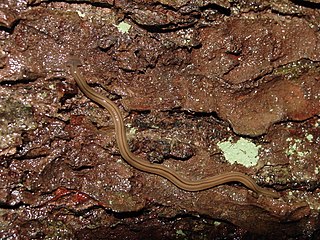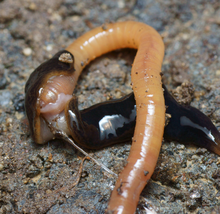
The New Zealand flatworm is a large land flatworm native to New Zealand. It can vary from 5 mm in length when hatched to approximately 17 centimetres (6.7 in) in mature adults.

Geoplanidae is a family of flatworms known commonly as land planarians or land flatworms.

Bipalium is a genus of large predatory land planarians. They are often loosely called "hammerhead worms" or "broadhead planarians" because of the distinctive shape of their head region. Land planarians are unique in that they possess a "creeping sole", a highly ciliated region on the ventral epidermis that helps them to creep over the substrate. Native to Asia, several species are invasive to the United States, Canada, and Europe. Some studies have begun the investigation of the evolutionary ecology of these invasive planarians.

Caenoplana coerulea, known as the blue planarian or blue garden flatworm is a species of land planarian.

Platydemus manokwari, also known as the New Guinea flatworm, is a species of large predatory land flatworm.

Platydemus is a genus of large predatory land planarians in the tribe Rhynchodemini.

Bipalium kewense, also known as the shovel-headed garden worm, is a species of large predatory land planarian with a cosmopolitan distribution. It is sometimes referred to as a "hammerhead flatworm" due to its half-moon-shaped head, but this name is also used to refer to other species in the subfamily Bipaliinae.

Bipalium adventitium, the wandering broadhead planarian, is a land planarian in the subfamily Bipaliinae. It has been accidentally introduced in the United States, where it is considered invasive.

Geoplaninae is a subfamily of land planarians endemic to the Neotropical region. Members of this family are sometimes referred to as the Neotropical land planarians. However, one species, Obama nungara has been introduced in Europe.

Obama is a genus of land planarians from South America. It contains several species adapted to human-disturbed environments, including the only invasive land planarian native to the Neotropical realm, Obama nungara, which has been accidentally introduced in Europe.

Bipaliinae is a subfamily of land planarians found mainly in Madagascar, the Indian subcontinent and Southeast Asia, although some species have been introduced worldwide.

Cratera is a genus of land planarians found in South America.

Diversibipalium multilineatum is a species of large predatory land flatworm.

Caenoplana is a genus of land planarians from Australia and New Zealand.

Endeavouria is a monotypic genus of land planarians from the Pacific region. It contains a single species, Endeavouria septemlineata.

Amaga is a genus of land planarians from South America.

Kontikia is a genus of land planarians native from islands in the Indo-Pacific region, but several species have been introduced elsewhere.

Bipalium vagum, the wandering hammerhead worm, is a land planarian in the subfamily Bipaliinae. It has been accidentally introduced in the United States, Bermuda and various islands in the Caribbean and was recorded for the first time in Europe, in Italy, in 2021.

Jean-Lou Justine, French parasitologist and zoologist, is a professor at the National Museum of Natural History in Paris, France, and a specialist of fish parasites and invasive land planarians.

Vermiviatum covidum is a species of predatory land flatworm, found in France and Italy. The Holotype specimen is MNHN JL351B.





















